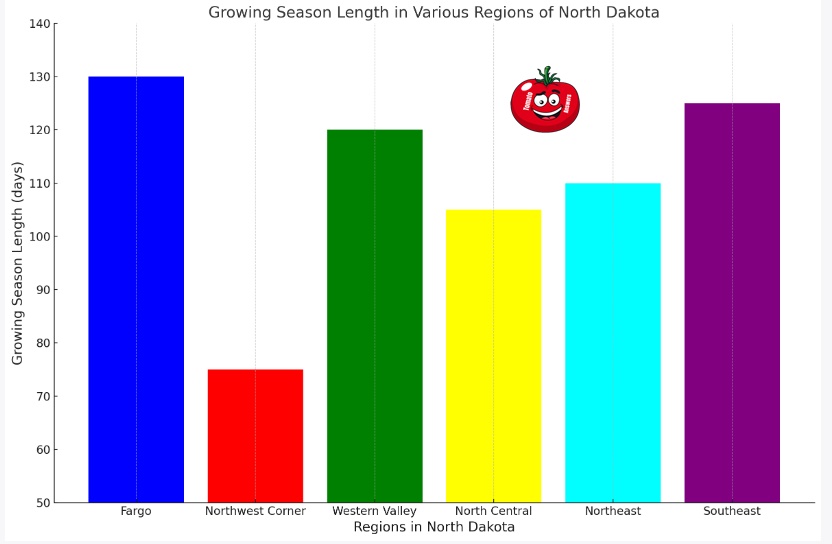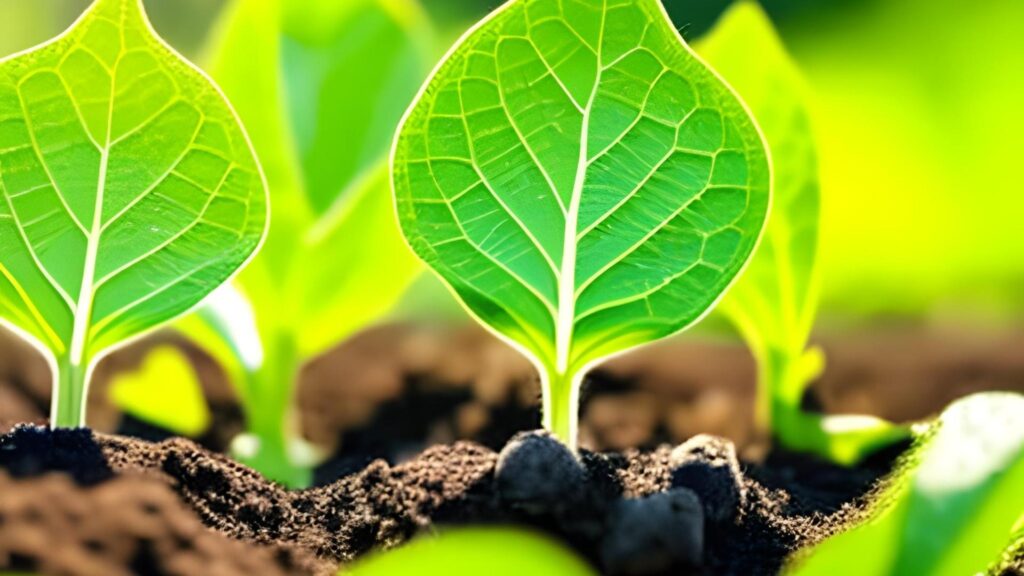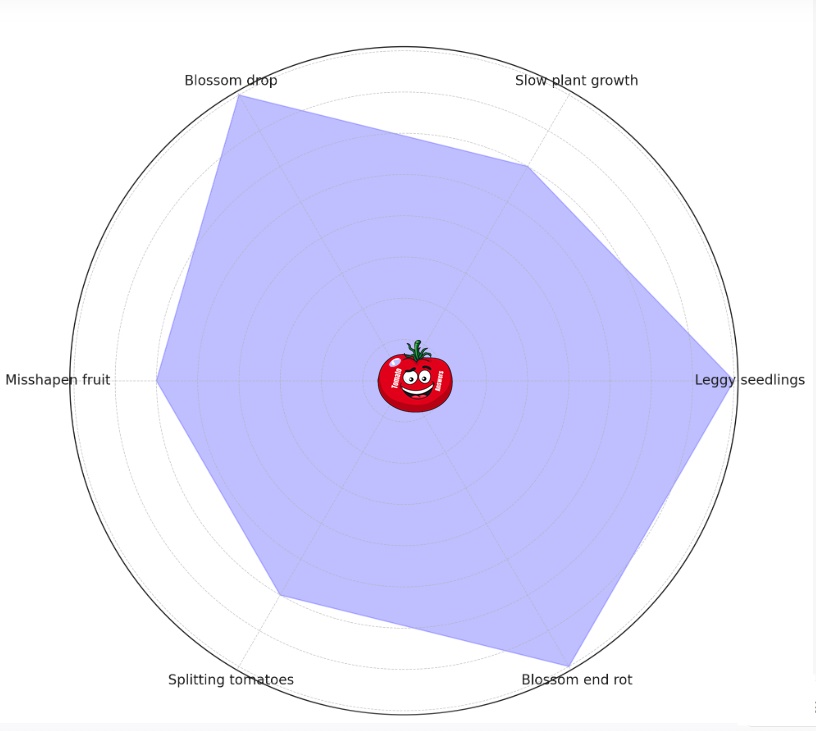In This Article
Key Takeaway
– 🍅 North Dakota has a short growing season and diverse microclimates, so timing is crucial for successful tomato planting.
– 🍅 The average growing season in North Dakota ranges from 60 to 130 days, depending on the location.
– 🍅 Tomatoes should not be planted outside until after the last spring frost, which varies across different regions in North Dakota.
– 🍅 North Dakota is divided into different planting zones, with zones 4a and 4b offering the best chances for successful tomato growth.
– 🍅 The soil temperature should be at least 60°F for germinating tomato seeds and 65-70°F for transplanting.
– 🍅 Early and fast-maturing tomato varieties are recommended for cooler climates like North Dakota, while heirlooms and late bloomers should be avoided.
– 🍅 Starting tomato seeds indoors under grow lights around February is recommended for most gardeners.
– 🍅 Transplanting tomato seedlings outside should be done approximately 2-4 weeks after the last spring frost, depending on the region.
– 🍅 Advanced techniques like using greenhouses, polytunnels, containers, and season extenders can help maximize the tomato growing season.
– 🍅 Common tomato problems in North Dakota include leggy seedlings, slow plant growth, blossom drop, misshapen fruit, splitting tomatoes, and blossom end rot.
– 🍅 Experienced North Dakota gardeners recommend starting seeds early, using poly tunnels, choosing suitable tomato varieties, and outsmarting frost for a longer season.
When To Plant Tomatoes In North Dakota? (Best Time and Expert Tips)
Knowing when to plant tomatoes in North Dakota is key to a successful crop. With the state’s short growing season and potential for cold snaps, timing is everything for Dakota tomato gardens. This guide will walk through the optimal tomato planting times and techniques in North Dakota.
We’ll cover factors like your USDA planting zone, first and last frost dates, soil temperatures, tomato types, whether to start seeds indoors and transplanting timelines. Follow these tomato tips from gardening experts to get your best yields.
How Long is the Growing Season in North Dakota?
Most North Dakota falls into USDA Hardiness Zones 3a or 3b, with an average growing season of around 90-120 days. However, the state has diverse microclimates ranging from zone 4a to 2b.
In Fargo, the season lasts from around May 10 to September 15 – about 130 days. While up in the northwest corner, the season shrinks to just 60-90 days.
These short seasons mean thoughtful planning is essential to grow warm-weather crops like tomatoes. Learning your first and last frost dates will allow you to maximize the limited growing time.
Last Frost Date in North Dakota
Tomatoes cannot be put outside until after the average last spring frost to avoid cold damage. When winter’s chill has passed, the soil has warmed, and nighttime temperatures remain over 45°F.
Here are the approximate average last frost dates for North Dakota locations:
- Western Valley – May 5-10
- North Central – May 10-20
- Northeast – May 15-25
- Southeast – May 1-10
The Red River Valley along the Minnesota border sees the earliest last frosts, while the colder northwest corner delays planting. Monitor long-range weather forecasts and be ready to protect plants from rogue late freezes.
First Fall Frost for North Dakota
While eagerly anticipating spring’s arrival, remember when cold temperatures return in fall. Know your average first frost date to properly time tomato planting.
Typical first fall frost dates across North Dakota:
- Western Valley – September 5-10
- North Central – September 10-20
- Northeast – September 15-25
- Southeast – September 20-30
When planning, factor in at least 2 months from transplanting tomatoes outside to fruit harvest before frost ends your season.
North Dakota Tomato Planting Zones
The United States Department of Agriculture (USDA) divides North Dakota into five distinct planting zones based on average coldest winter temperatures.
Zone 4a – Minimum -30 to -35°F Found along the state’s eastern edge with a season from May 10 to September 30. It can support tomato growth with protection.
Zone 3b – Minimum -35 to -40°F a giant slice of North Dakota, including Fargo, Jamestown, and Devils Lake. Challenging for tomatoes but possible with early starts and short-season varieties.
Zone 3a – Minimum -40 to -45°F Covers a swath of north central North Dakota. Tomato growing is challenging but doable with extra measures.
Zone 2b – Minimum -45 to -50°F
In the far northwest region. Too cold for reliable tomato production except in sheltered microclimates and greenhouses.
Zone 4b – Minimum -25 to -30°F A tiny section of Richland County on the southeast border. Earliest planting and best zone in the state for tomatoes.
So, in summary, zones 4b and 4a offer the best chances while zone 2b is too cold. Know your zone before planting!
Ideal Soil Temperature for Planting Tomatoes in North Dakota
The actual test for if conditions are ripe for transplanting tomato starts is soil temperature, not just the date on the calendar. Tomatoes require warm soil at least 60°F to germinate when direct sowing and thrive when appropriately transplanted.
Here are the recommended minimum soil temperatures for the best tomato growth:
- Seeds – 60°F
- Transplants – 65-70°F
A thermometer probe inserted at planting depth is the most accurate way to track soil temp. If lacking a thermometer, pay attention to these signs soil is warm enough:
- Night air temperatures over 55°F
- Grass greens up
- Dandelions bloom
- Bare ground is warmed by the sun
- Bare feet can tolerate standing for over a minute
Tomatoes will not correctly grow until the soil thoroughly warms. Planting too early in cold ground results in stunted, stressed plants. Be patient!
Tomato Varieties for North Dakota
With the climate challenges, North Dakota gardeners must select short-season tomato varieties adapted to more excellent conditions. Prioritize early and fast-maturing types that can be harvested before killing frosts.
Recommended varieties include:
- Early Girl
- First Lady
- Glacier
- Legend
- Mountain Merit
- Oregon Spring
- Parks Whopper
- Polish Linguisa
- Siberia
- Stupice
- Sub Arctic Maxi
Look for hybrids and cultivars specifically bred for cool climates. Determinate, dwarf, and patio types also prosper in North Dakota.
Avoid heirlooms, late bloomers, and those requiring long seasons to ripen like beefsteaks fully. Stick with compact plants that fruit quickly.
When to Start Tomato Seeds Indoors in North Dakota
The short outdoor growing window means most gardeners should start tomatoes indoors under lights or in a greenhouse.
Tomatoes require around 6-8 weeks of growing time before hardening off and transplanting. Count backward from your average last spring frost to determine ideal seed starting dates.
General North Dakota seed starting times:
- Western Valley – Mid-March
- North Central – Late March
- Northeast – Early April
- Southeast – Mid to Late March
Monitor your seedlings closely and adjust grow lights to prevent leggy, overgrown plants before moving them outside around late May through early June.
Transplanting Tomatoes Outside in North Dakota
Timing the transplant is crucial to maximize North Dakota’s short season while avoiding cold damage. As an overall guideline, set out mature tomato starts around 2-4 weeks after your area’s average last spring frost.
Target transplant windows:
- Western Valley – Early to Mid May
- North Central – Mid to Late May
- Northeast – Late May to Early June
- Southeast – Early to Mid May
A week or two before transplanting, begin “hardening off” plants by slowly exposing them to more sun and bringing them outside temporarily on warmer days.
Then on transplant day, plant seedlings were slightly more profound than growing indoors. Water deeply and use cloches, cold frames, or row covers if the air or soil remains chilly.
Gardening Tips for Growing Tomatoes in North Dakota
To overcome the challenges of the Zone 3 climate, use these tomato care tips to give your plants their best shot at success:
- Start seeds early – don’t rush, or you’ll get leggy plants.
- Harden off gradually before transplanting to avoid shock.
- Use black or red plastic mulch to heat soil for faster growth.
- Install floating row covers at transplant for extra cold protection.
- Use Wall O’ Waters, water walls, cloches, or cold frames to shield plants.
- Transplant on cloudy days or late afternoon to prevent wilting.
- Space plants close – 18″ for determinate and 24″ for indeterminate to retain heat.
- Prune suckers and lower leaves to focus energy on fruiting. But don’t over-prune.
- Irrigate carefully to keep the soil evenly moist but not muddy.
- Side dress with nitrogen fertilizer monthly to aid growth in excellent soils.
- Apply organic mulch-like straw around plants to retain soil heat.
- Monitor for pests like blight, cutworms, and hornworms that thrive in cooler temps.
With extra care and protection, North Dakota gardeners can expand their growing options to include tomatoes. Just be ready to adapt to the challenges of an abbreviated season.
North Dakota Tomato Planting Schedule
Here is a helpful timeline for critical milestones when growing tomatoes in North Dakota:
- Late February to Mid March – Start seeds indoors 6-8 weeks before transplant target.
- Early to Mid May – Harden off seedlings before transplanting outside.
- Mid-May to Early June – Transplant mature plants outside approximately 2-4 weeks after the last frost. Use season extenders.
- June – Install trellises and cages. Side dress with nitrogen fertilizer.
- July – Pinch suckers. Prune lower leaves. Monitor soil moisture.
- Mid-July to August – Begin harvesting! Enjoy tomatoes for 6-8 weeks until the first fall frost.
- September – Manage plants to eke out final harvests. Plan next year’s garden.
With forethought and preparation starting each February, North Dakota gardeners can enjoy a steady tomato crop during the short summer season. Just stay diligent against threats like cold snaps.
How to Maximize the Tomato Growing Season in North Dakota
The most common gardening question in North Dakota is, “How can I get the longest tomato season possible?” While the weather is the biggest challenge, you can stretch out your harvests using these advanced techniques:
- Start seeds indoors as early as February using grow lights and heat mats.
- Before the last frost, construct small greenhouse structures or polytunnels to plant in late April/early May.
- Use large 5+ gallon containers to grow tomatoes on south-facing patios and decks for extra warmth.
- Install black or IRT poly mulch over beds to boost soil temps before planting.
- Cover plants daily with hot caps, cloches, cold frames, and fabric row covers.
- Train indeterminate tomatoes as single leaders on tall stakes to accelerate growth.
- Prune lower leaves and任ranches to focus energy on ripening existing fruit before frost.
- Pick tomatoes prematurely once fall arrives and ripen indoors to “harvest” more overall fruit.
- Move containers to protected areas on cold nights to stretch the season longer.
- Record results yearly and steadily adjust timing and techniques to find your optimal season extenders.
With diligent care and preparation starting in February, many North Dakota tomato growers can reliably achieve 4 months of fresh tomatoes.
Container Tomato Gardening in North Dakota
Short on garden space or have poor soil? Container gardening is an excellent option for North Dakota tomatoes. Use these container-growing tips:
- Choose determinate, dwarf, and early varieties suited for pots like Tumbling Tom.
- Utilize large 5+ gallon containers for bigger plants and harvests.
- Use potting mix formulated for vegetables to provide adequate nutrition.
- Amend soil with extra compost or fertilizer since nutrients leach out faster.
- Allow at least 6 hours of sun exposure, ideally on south-facing porches or patios.
- Shelter containers next to the house or group together to retain more warmth.
- Keep soil consistently moist – small pots dry out fast. Use drip irrigation if possible.
- Adjust location to chase the sun and shift indoors on cold nights as needed.
- Reduce watering towards season end to help manage excess foliage.
Container tomato plants can successfully fruit indoors and outside North Dakota with proper care. Just stay vigilant!
Common Tomato Problems in North Dakota (And How to Fix!)
The climate stresses of northern gardening lead to some typical tomato troubles in North Dakota:
- Leggy seedlings – Start seeds earlier indoors and increase light exposure. Avoid over-fertilizing.
- Slow plant growth – Raise temperatures with row covers and black plastic mulch. Fertilize more to aid development.
- Blossom drop – Improve pollination by shaking plants daily to distribute pollen. Cold temps also cause flowers to abort.
- Misshapen fruit – Caused by cold nighttime temperatures. Not much to do except select resistant varieties.
- Splitting tomatoes – Water evenly to prevent excessive moisture uptake. Pick frequently before maturity.
- Blossom end rot – Add dolomitic lime and steady soil moisture to prevent this common disorder.
You can overcome challenges and succeed with North Dakota tomatoes with attentive care and preventative techniques! Just get set up as early as February.
Tomato Growing Tips from North Dakota Gardeners
To wrap up, here are some words of wisdom from experienced tomato growers around North Dakota:
“I start my seeds under grow lights in my basement in late February. My wife thinks I’m crazy watering little plants for months just to get tomatoes weeks earlier!” – Steve D., Grand Forks
“The secret is tunnels! I build DIY poly tunnels over my beds to give my tomatoes an extra few weeks on both ends before the frost takes them.” – Megan T., Minot
“Don’t bother with those giant beefsteak varieties up here. I’ve had the best luck with early determinate cherries in black buckets on my patio.” – Dan K., Fargo
“It’s frustrating but fun trying to outsmart Mother Nature and get a few more tomatoes before the first September frost.” – Wendy V., Bismarck
No matter your preferred growing methods, with proper planning, protection, and care, North Dakota gardeners can succeed with tomatoes. Just focus on fast-growing early varieties suited to cooler climates.
Now you know the best times and techniques for planting tomatoes in North Dakota. Follow this guide’s tips to maximize your short-growing window.
With thoughtful preparation starting as early as February, you can enjoy months of juicy homegrown tomatoes. Just be ready to adapt as needed to outwit the challenges of your Zone 3 climate. Happy growing North Dakota!
Are You New To Tomato Answers?
If you are new to Tomato Answers, here are a few resources to help you:
- Living in Oklahoma and planning your tomato garden? Learn When to Plant Tomatoes in Oklahoma.
- Not sure about the best time to plant in Indiana? Discover When to Plant Tomatoes in Indiana.
- Planning your tomato garden in Iowa? Find out When to Plant Tomatoes in Iowa.
- Looking to grow tomatoes in the beautiful state of Colorado? Learn When to Plant Tomatoes in Colorado.
- Planting tomatoes in the sunny state of Florida? Here’s When to Plant Tomatoes in Florida.
- Planting tomatoes in the vast lands of Alaska? Learn When to Plant Tomatoes in Alaska.






